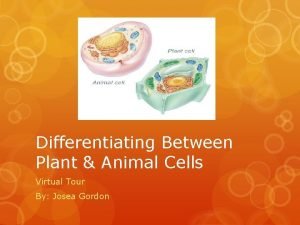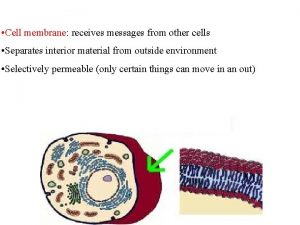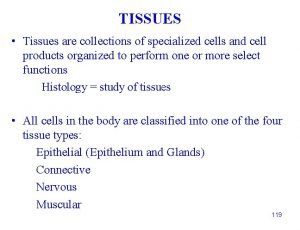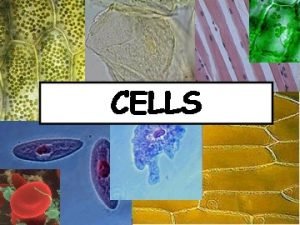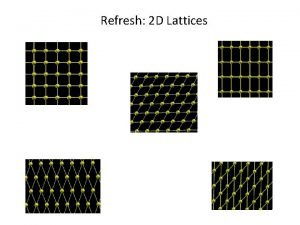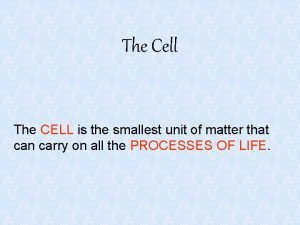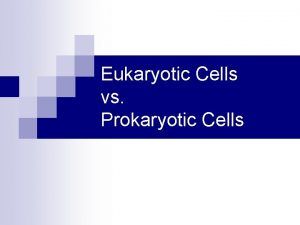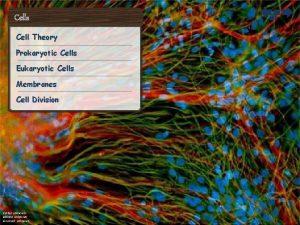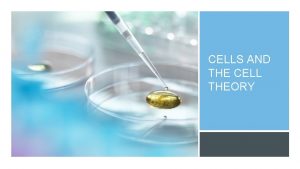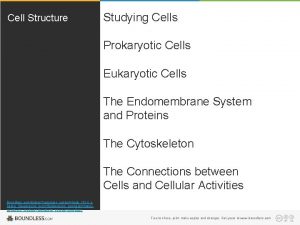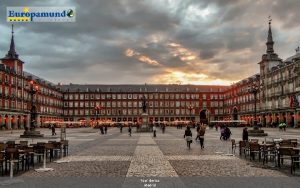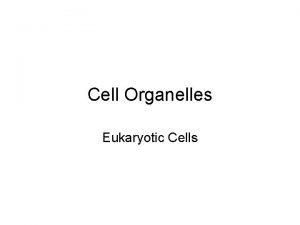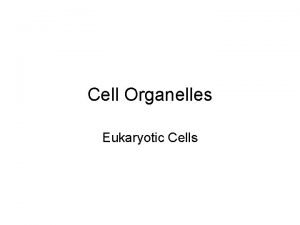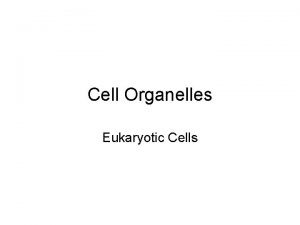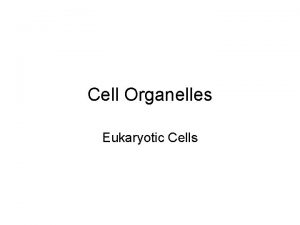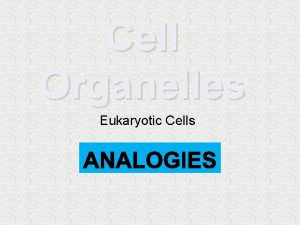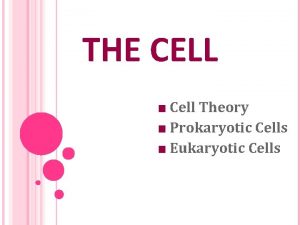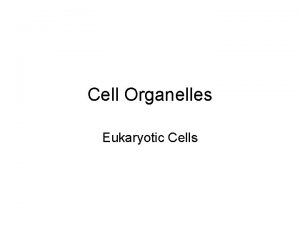Unit A Cells A Tour of the Cell


































- Slides: 34

Unit A: Cells A Tour of the Cell

By the end of this unit you should be able to: Standards Recognize and explain the function of each organelle Look at micrographs/diagrams/pictures and correctly ID each organelle Write/work with/explain the balanced chemical equation for cellular respiration Relate the role of an organelle to a specific part of the body Explain how the endomembrane system functions to compartmentalize the cell and move materials through it

Big Picture – in case you did not know!!! Life = Cells Cell Intro Cells=prokaryotic (bacteria) OR eukaryotic (all other) How do you recognize? ?

Cells EVERYWHERE!!! Staphylococcus aureus Apoptosis in a Leukemia Cell – Cell Suicide Human Red Blood Cells Escherichia coli

How big is a cell? ? Cells Everywhere!!! How many cells in your body? ? ? 50 million (50 trillion) cells – stretched end to end they would stretch around the Earth 47 times – if you could count one cell per second it would take you 2600 years !!! Inner Life of Cell

What cells can you see? ? ? Hummingbird Egg – 0. 02 ounces Human Egg – Thousands of dollars per egg 25 G’s Beluga sturgeon Eggs - $700 per ounce

10 m Human height 1 m 100 mm (10 cm) 10 mm (1 cm) Frog egg 1 mm 100 m Most plant and animal cells 10 m Nucleus Most bacteria 1 m Mitochondrion Mycoplasmas (smallest bacteria) 100 nm Viruses Ribosome 10 nm Proteins Lipids 1 nm Small molecules 0. 1 nm Atoms Electron microscope Most cells are microscopic Light microscope What cells can you see? ? ? Cells vary in size and shape Chicken egg Unaided eye Length of some nerve and muscle cells

Surface area to volume ratio The microscopic size of most cells ensures a sufficient sur face area Across which nutrients and wastes can move to service the cell volume A small cell has a greater ratio of sur face area to volume than a large cell of the same shape 10 m 30 m Surface area of one large cube 5, 400 m 2 10 m Total surface area of 27 small cubes 16, 200 m 2

A. Prokaryotic cell Colorized TEM 15, 000 Prokaryotic cells are structurally simpler than eukar yotic cells Recall: there are two kinds of cells Prokaryotic and eukaryotic, which is which and how do you know? Nucleoid region Nucleus Eukar yotic cell B. Organelles

Prokaryotic cells are small, relatively simple cells That do not have a membrane-bound nucleus You should recall the “bits” from Gr 11 microbiology (bacteria) Prokaryotic Cells Prokar yotic flagella Ribosomes Capsule Cell wall Plasma membrane Nucleoid region (DNA) Pili

Eukaryotic cells are partitioned into functional compartments (organelles) Eukaryotic Cells All other forms of life (anything not bacteria) are composed of more complex eukaryotic cells Distinguished by the presence of a true nucleus Membranes form the boundaries of and within many eukaryotic cells Compartmentalizing the interior of the cell into organelles and facilitating a variety of metabolic activities

There are two types of Eukaryotic cells: animal and plant A typical animal cell contains a variety of membranous organelles Types of Eukaryotic Cells Rough endoplasmic reticulum Smooth endoplasmic reticulum Nucleus Flagellum Not in most plant cells Lysosome Ribosomes Centriole Peroxisome Microtubule Cytoskeleton Intermediate filament Microfilament Golgi apparatus Plasma membrane Mitochondrion

Types of Eukaryotic Cells A typical plant cell has some structures that an animal cell lacks Such as chloroplasts, a rigid cell wall and a central vacuole Nucleus Rough endoplasmic reticulum Ribosomes Golgi apparatus Not in animal cells Central vacuole Chloroplast Cell wall Mitochondrion Peroxisome Plasma membrane Smooth endoplasmic reticulum Microtubule Intermediate filament Microfilament Cytoskeleton

Plant and Animal Differences: The 4 C’s! Plant Cell Animal Cell wall Centrioles Chloroplasts Central Vacuole

All other organelles found here Defined by cell membrane & envelope Cytoskeleton – maintains cell’s shape Cytoplasm

The nucleus is the cell’s genetic control center Its the largest organelle which is separated from the cytoplasm by the nuclear envelope The nucleus is the cellular control center It contains the cell’s DNA, which directs cellular activities The Nucleus Chromatin Nucleolus Nucleus Two membranes of nuclear envelope Pore Rough endoplasmic reticulum Ribosomes

i) Nuclear Envelope – 2 membranes with pores Nuclear Structure ii) Chromatin – thread like Becomes chromosomes* (condensed) during cell division *Contains genetic material (DNA): Meaningful parts = genes Made of - DNA & proteins iii) Nucleolus – dark center Makes r. RNA (ribosomal RNA)

Many cell organelles are Endomembrane connected through the System endomembrane system a collection of membranous organelles that manufactures and distributes cell products Nucleus, RER, SER, Golgi, Vesicles, Vacuoles

Smooth endoplasmic reticulum (SER) has a variety of functions Smooth ER Rough ER Nuclear envelope Ribosomes Smooth ER Rough ER TEM 45, 000 SER Synthesizes lipids Processes toxins and drugs in liver cells Stores and releases calcium ions in muscle cells

Rough endoplasmic reticulum (RER) makes membrane and proteins Ribosomes on the sur face of the RER Produce proteins that are secreted, inserted into RER membranes, or transported in vesicles to other organelles RER And Ribosomes 4 stages of protein synthesis? ? ?

ER – interconnected membrane, tubular canals, begin at nuclear envelope ER Comparison RER SER Studded with ribosomes NO ribosomes Synthesize proteins for export (use outside of the cell) Ex - insulin Synthesize lipids (ex. Male testes – make testosterone – a lipid steroid – so lots of SER) Help liver in detox. process

2 Types of Ribosomes Free Floating Embedded in RER Make proteins for cell use (internal) Make proteins for export out of cell (external)

Stacks of membranous sacs receive and modify ER products then ships them to other organelles or the cell sur face “Receiving” side of Golgi apparatus Transport vesicle from ER New vesicle forming “Shipping” side of Golgi apparatus Transport vesicle from the Golgi TEM 130, 000 Golgi Apparatus The Golgi apparatus finishes, sorts, and ships cell products

Lysosomes are digestive compar tments within a cell Lysosomes Sacs of hydrolytic enzymes that function in hydrolysis (digestion) within a cell Double membrane bound and made by GA Function in autodigestion EX: tadpole tail, finger webbing Rough ER 1 Transport vesicle (containing inactive hydrolytic enzymes) Plasma membrane Golgi apparatus “Food” 2 Engulfment of particle Lysosomes Lysosome engulfing damaged organelle 3 5 4 Food vacuole lysosomes clip Digestion

Lysosomes in white blood cells Destroy bacteria that have been ingested Lysosomes also recycle damaged organelles Lysosome containing two damaged organelles Abnormal lysosomes can cause fatal diseases (Lysosomal storage diseases) which interfere with various cellular functions Lysosome Peroxisome fragment TEM 8, 500 Nucleus TEM 42, 500 Mitochondrion fragment

Nucleus Chloroplast Contractile vacuoles LM 650 Central vacuole Colorized TEM 8, 700 Vacuoles function in the general maintenance of the cell Plant cells contain a large central vacuole which has lysosomal and storage functions as well as support functions Some protists have contractile vacuoles that pump out excess water

The various organelles of the endomembrane system are interconnected structurally and functionally A review of the endomembrane system Rough ER Transport vesicle from ER to Golgi Transport vesicle from Golgi to plasma membrane Plasma membrane Nucleus Vacuole Lysosome Smooth ER Nuclear envelope Golgi apparatus

Chloroplasts convert solar energy to chemical energy ENERGYCONVERTING ORGANELLES Chloroplasts, found in plants and some protists, conver t solar energy to chemical energy in sugars (glucose) Contains chlorophyll Chloroplast Inner and outer membranes Granum Intermembrane space TEM 9, 750 Stroma

Mitochondria harvest chemical energy from food Mitochondria carry out cellular respiration which uses the chemical energy in food (glucose) to make ATP for cellular work OXYGEN + GLUCOSE ---- CARBON DIOXIDE + ATP + WATER ENERGY- Double membrane bound, has own DNA Mitochondrion CONVERTING ORGANELLES Outer membrane Inner membrane Cristae Matrix TEM 44, 880 Intermembrane space

The cell’s internal skeleton helps organize its structure and activities A network of protein fibers make up the cytoskeleton. Microfilaments of actin Enable cells to change shape and move Intermediate filaments Reinforce the cell and anchor certain organelles Cytoskeleton Microtubules give the cell rigidity And provide anchors for organelles and act as tracks for organelle movement Tubulin subunit Actin subunit Fibrous subunits 7 nm Microfilament 25 nm 10 nm Intermediate filament Microtubule

Cilia and flagella move when microtubules bend Eukaryotic cilia and flagella are locomotor appendages that protrude from certain cells Clusters of microtubules drive the whipping action of these organelles Cilia and Flagella Flagellum Electron micrographs of cross sections: Outer microtubule doublet TEM 206, 500 Central microtubules Radial spoke Dynein arms Figure 4. 17 A 4. 17 C LM 600 Basal body (structurally identical to centriole)Figure 4. 17 B TEM 206, 500 Colorized SEM 4, 100 Plasma membrane Flagellum

Cell sur faces protect, support, and join cells Cells interact with their environments and each other via their sur faces. CELL SURFACES AND JUNCTIONS Plant cells Are supported by rigid cell walls made largely of cellulose Connect by plasmodesmata, which are connecting channels Walls of two adjacent plant cells Vacuole Plasmodesmata Layers of one plant cell wall Cytoplasm Plasma membrane

Animal cells are embedded in an extracellular matrix which binds cells together in tissues CELL SURFACES AND JUNCTIONS Tight junctions can bind cells together into leak-proof sheets Anchoring junctions link animal cells into strong tissues Gap junctions allow substances to flow from cell to cell Tight junctions Anchoring junction Gap junctions Extracellular matrix Space between cells Plasma membranes of adjacent cells

Eukaryotic organelles comprise four functional FUNCTIONAL CATEGORIES OF ORGANELLES categories Eukar yotic organelles fall into four functional groups Manufacturing Breakdown Energy processing Suppor t, movement, and communication between cells Table 4. 19
 Tour eiffel tours petronas shanghai world financial
Tour eiffel tours petronas shanghai world financial Tour guide vs tour escort
Tour guide vs tour escort Dangerous world tour history world tour - hockenheimring
Dangerous world tour history world tour - hockenheimring Virtual plant cell
Virtual plant cell A tour inside the cell answers
A tour inside the cell answers Chapter 6 a tour of the cell answers
Chapter 6 a tour of the cell answers Chapter 4 a tour of the cell
Chapter 4 a tour of the cell A tour of the cell chapter 4
A tour of the cell chapter 4 Onodi cells and haller cells
Onodi cells and haller cells Regulation of tubular reabsorption
Regulation of tubular reabsorption Thyroid parafollicular cells
Thyroid parafollicular cells How are somatic cells different from gametes
How are somatic cells different from gametes Why dna is more stable than rna
Why dna is more stable than rna Chlorocruorin
Chlorocruorin Eukaryotic vs prokaryotic cells
Eukaryotic vs prokaryotic cells Similarities between plant and animal cells venn diagram
Similarities between plant and animal cells venn diagram Prokaryotic cells
Prokaryotic cells Why did robert hooke name cells “cells”?
Why did robert hooke name cells “cells”? Masses of cells form and steal nutrients from healthy cells
Masses of cells form and steal nutrients from healthy cells Label
Label Are plant cells prokaryotic or eukaryotic
Are plant cells prokaryotic or eukaryotic Are red blood cells prokaryotic
Are red blood cells prokaryotic Nondisjunction in meiosis
Nondisjunction in meiosis Cells and life lesson 1 answer key
Cells and life lesson 1 answer key Germ cell vs somatic cells
Germ cell vs somatic cells Collection of specialized cells and cell products
Collection of specialized cells and cell products Unit 10, unit 10 review tests, unit 10 general test
Unit 10, unit 10 review tests, unit 10 general test Cells are the smallest unit of life
Cells are the smallest unit of life Cells are the smallest unit of life
Cells are the smallest unit of life Types of unit cell
Types of unit cell A cell is the smallest unit of life
A cell is the smallest unit of life Cells are the basic unit of life true or false
Cells are the basic unit of life true or false Hát kết hợp bộ gõ cơ thể
Hát kết hợp bộ gõ cơ thể Slidetodoc
Slidetodoc Bổ thể
Bổ thể



